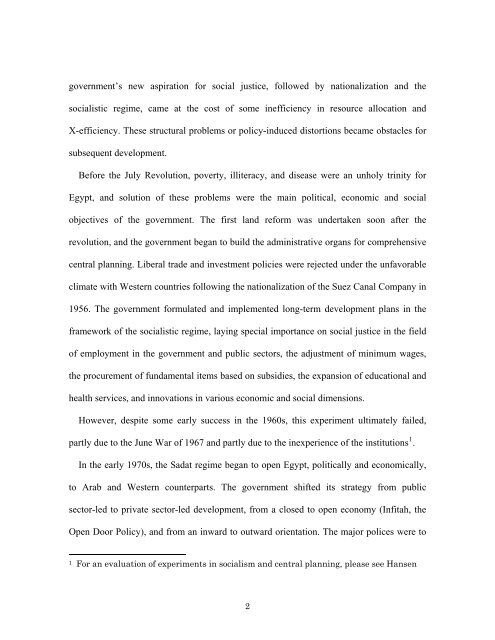Title Sustainable Development and Poverty Reduction under ...
Title Sustainable Development and Poverty Reduction under ...
Title Sustainable Development and Poverty Reduction under ...
- No tags were found...
You also want an ePaper? Increase the reach of your titles
YUMPU automatically turns print PDFs into web optimized ePapers that Google loves.
government’s new aspiration for social justice, followed by nationalization <strong>and</strong> thesocialistic regime, came at the cost of some inefficiency in resource allocation <strong>and</strong>X-efficiency. These structural problems or policy-induced distortions became obstacles forsubsequent development.Before the July Revolution, poverty, illiteracy, <strong>and</strong> disease were an unholy trinity forEgypt, <strong>and</strong> solution of these problems were the main political, economic <strong>and</strong> socialobjectives of the government. The first l<strong>and</strong> reform was <strong>under</strong>taken soon after therevolution, <strong>and</strong> the government began to build the administrative organs for comprehensivecentral planning. Liberal trade <strong>and</strong> investment policies were rejected <strong>under</strong> the unfavorableclimate with Western countries following the nationalization of the Suez Canal Company in1956. The government formulated <strong>and</strong> implemented long-term development plans in theframework of the socialistic regime, laying special importance on social justice in the fieldof employment in the government <strong>and</strong> public sectors, the adjustment of minimum wages,the procurement of fundamental items based on subsidies, the expansion of educational <strong>and</strong>health services, <strong>and</strong> innovations in various economic <strong>and</strong> social dimensions.However, despite some early success in the 1960s, this experiment ultimately failed,partly due to the June War of 1967 <strong>and</strong> partly due to the inexperience of the institutions 1 .In the early 1970s, the Sadat regime began to open Egypt, politically <strong>and</strong> economically,to Arab <strong>and</strong> Western counterparts. The government shifted its strategy from publicsector-led to private sector-led development, from a closed to open economy (Infitah, theOpen Door Policy), <strong>and</strong> from an inward to outward orientation. The major polices were to1 For an evaluation of experiments in socialism <strong>and</strong> central planning, please see Hansen2




![Title [書評] 廣田義人著『東アジア工作機械工業の技術形成 ... - ARRIDE](https://img.yumpu.com/47139953/1/184x260/title-arride.jpg?quality=85)






